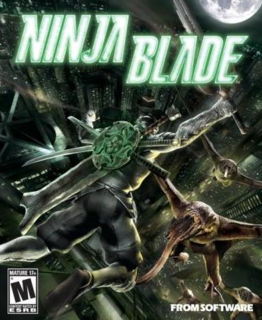The combination of a bad camera and an overuse of OTE's cripples what could have been a fairly enjoyable action game.
Ninja Blade follows the story of one Ken Ogawa, a modern day Ninja who has been dispatched to Tokyo as part of an international effort to control the outbreak of a parasitic lifeform mutating people into monsters known as Carriers. As the infection rapidly spreads out of control, Ken and his Ninja buddies are sent to contain the outbreak and eliminate its source.
Each level sees Ken taking down monsters by the dozen while armed with a trio of different swords, including a pair of shortswords ideal for handling fast-moving opponents or grappling onto environmental features, a gigantic broadsword that trades speed and finesse for raw strength along with the ability to break down weak walls, and a third sword that strikes a balance between the two, offering the player agility and power in one package. Ken is also equipped with a giant Shuriken, enabling him to burn through barriers or stun enemies temporarily with electricity. Cutting down enemies rewards the player with Blood Crystals, which can be used to improve their weapons by increasing their damage output and adding new moves to Ken's repertoire. Also at the hero's disposal is the ever handy Ninja Vision, a vision mode that highlights the weaknesses of nearby adversaries at the expense of raising Ken's susceptibility to harm. Breaking up the regular toe-to-toe combat are several on-rails sections that see Ken take control of a mounted weapon onboard an armoured car or helicopter. The Carriers themselves aren't' particularly smart, and rarely pose a great threat to the player. In fact, most of the levels will rarely ever see the player in any real danger until they come face to face with one of Ninja Blade's many Bosses. This is where Ninja Blade stumbles over its own design and falls flat on its face.
It's very difficult to find a single Boss that doesn't suffer from ridiculously bad design. This becomes a major issue when one realizes that literally every level features at least two Bosses each. In most cases the player will be expected to dodge a swarm of projectiles unleashed by the Boss before closing in for a melee attack. The fact that the camera has a habit of positioning itself directly behind Ken makes this a lot harder than it really should be. It doesn't help matters that Boss battles often come down to memorizing the enemy's pattern of attack, the manner through which to counter that pattern, and remembering to use the right sword at the right to chip away at the Boss' health. This process is simply repetitive and lacks any real challenge. Once the player does actually manage to deplete the enemy's Health gauge, they're prompted to perform a 'Todome' strike to finish the Boss for good, which boils down to completing a series of relatively easy QTE's to deliver the killing blow by crushing Ken's opponent with a well-placed wrecking ball or by dropping a bus on top on its head. Fortunately the Todome Boss finishes are always fun to watch and feature some of the most outrageous action scenes from any game to date, with one of the most memorable being the aforementioned scenario in which Ken hits a wrecking ball and jumps on top of the thing as it swings round, before he eventually detaches the ball and hurls it into a giant spider. Moments like these are the highlights of Ninja Blade and are without a doubt its strongest asset. Ironically, they also point out Ninja Blade's most distinguishing feature, and unfortunately the game's most prominent flaw – its over-reliance on QTE's.
A significant portion of the time playing Ninja Blade is spent clearing QTE after QTE while watching Ken swing across skyscrapers Spiderman style before commandeering a motorcycle in mid-air and riding it down an enemy's throat. While it is undeniably very spectacular to watch the hero pull off these amazing stunts, it's also very difficult not to feel that the overall experience was dumbed down for players unacquainted with the action genre, given that the player isn't actually performing any of these impressive feats themselves, but instead simply pressing a series of buttons in the correct order to achieve the same result.
One thing that Ninja Blade does have going for it is aesthetic appeal. The lighting effects and textures look great during the QTE events. Sparks illuminate the intricate details of Ken's outfit as he slides down the side of tall buildings before breaking into a free fall and gliding over the Tokyo at night. The lights from the city below are indeed a mesmerizing sight to behold and do a great job of giving the impression that they really are flying over Tokyo. As an added extra it's also possible to customize Ken's attire by mixing and matching colours and patterns to one's liking. Tired of that jet black Ninja get-up? No problem, just don that superhero or clown outfit and you're good to go.
Ninja Blade is a game that lacks the same polish possessed by its main contenders. The combat never feels quite as satisfying as it does in Ninja Gaiden or Otogi. And when it does pick up the pace, it quickly returns to dragging its heels along the ground shortly thereafter by thrusting QTE after QTE into the player's face with monotonous regularity. Admittedly Ninja Blade does look very flashy, and Ken's over-the-top stunts never fail to impress, but in this day and age, it takes more than a handful of nice flashy lights and a protagonist capable of riding a missile like a surfboard while dressed in an outrageous outfit to leave a long lasting, positive impression on a player.

